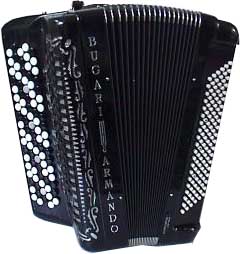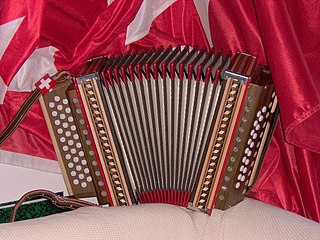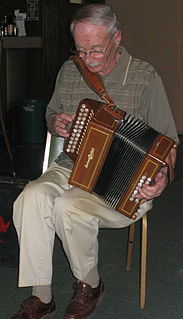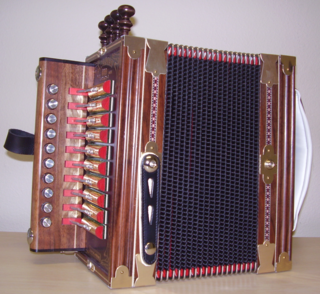
The modern organetto is a small diatonic button accordion used in Italian folk music. [1] [2] [3] It is often used to play the saltarello.

The modern organetto is a small diatonic button accordion used in Italian folk music. [1] [2] [3] It is often used to play the saltarello.

Accordions are a family of box-shaped musical instruments of the bellows-driven free-reed aerophone type, colloquially referred to as a squeezebox. A person who plays the accordion is an accordionist. The concertina, harmoneon and bandoneón are related. The harmonium and American reed organ are in the same family, but are typically larger than an accordion and sit on a surface or the floor.

Cajun music, an emblematic music of Louisiana played by the Cajuns, is rooted in the ballads of the French-speaking Acadians of Canada. Although they are two separate genres, Cajun music is often mentioned in tandem with the Creole-based zydeco music. Both are from southwest Louisiana and share French and African origins. These French Louisiana sounds have influenced American popular music for many decades, especially country music, and have influenced pop culture through mass media, such as television commercials.

A semitone, also called a half step or a half tone, is the smallest musical interval commonly used in Western tonal music, and it is considered the most dissonant when sounded harmonically. It is defined as the interval between two adjacent notes in a 12-tone scale. For example, C is adjacent to C♯; the interval between them is a semitone.

The garmon, commonly called garmoshka, is a kind of Russian button accordion, a free-reed wind instrument. A garmon has two rows of buttons on the right side, which play the notes of a diatonic scale, and at least two rows of buttons on the left side, which play the primary chords in the key of the instrument as well as its relative harmonic minor key. Many instruments have additional right-hand buttons with useful accidental notes, additional left-hand chords for playing in related keys, and a row of free-bass buttons, to facilitate playing of bass melodies.

The trikititrikitixa, or eskusoinu txiki ) is a two-row Basque diatonic button accordion with right-hand rows keyed a fifth apart and twelve unisonoric bass buttons. The onomatopoeia trikitixa, apparently stemming from the sound emitted by the tambourine, originally referred to a traditional Basque ensemble, made up of the instrument which now bears the name as well as alboka, txistu and other instruments.
The Music of Sicily refers to music created by peoples from the isle of Sicily. It was shaped by the island's history, from the island's great presence as part of Magna Grecia 2,500 years ago, through various historical incarnations as a part of the Roman Empire, then as an independent state as the Emirate of Sicily then as an integral part of the Kingdom of Sicily and later the Kingdom of the Two Sicilies, and, finally, as an autonomous region of the modern nation state of Italy.

A button accordion is a type of accordion on which the melody-side keyboard consists of a series of buttons. This differs from the piano accordion, which has piano-style keys. Erich von Hornbostel and Curt Sachs categorize it as a free reed aerophone in their classification of instruments, published in 1914. The sound from the instrument is produced by the vibration of air in reeds. Button accordions of various types are particularly common in European countries and countries where European people settled. The button accordion is often confused with the concertina; the button accordion's buttons are on the front of the instrument, where as the concertina's are on the sides and pushed in parallel with the bellows.

The Flutina is an early precursor to the diatonic button accordion, having one or two rows of treble buttons, which are configured to have the tonic of the scale, on the "draw" of the bellows. There is usually no bass keyboard: the left hand operates an air valve. A rocker switch, called a "bascule d'harmonie" is in the front of the keyboard. When this switch is thumb activated, it would open up a pallet (a pad that covers a tone hole, at the other end of the key button, for a simple Tonic/Dominant drone: Tonic on the draw and Dominant on the press, e.g. Tonic notes C/g, and Dominant G/d, without any major or minor thirds.

A chromatic button accordion is a type of button accordion where the melody-side keyboard consists of rows of buttons arranged chromatically. The bass-side keyboard is usually the Stradella system or one of the various free-bass systems. Included among chromatic button accordions are the Russian bayan and Schrammel accordion. There can be 3 to 5 rows of vertical treble buttons. In a 5 row chromatic, two additional rows repeat the first 2 rows to facilitate options in fingering.

A melodeon or diatonic button accordion is a member of the free-reed aerophone family of musical instruments. It is a type of button accordion on which the melody-side keyboard contains one or more rows of buttons, with each row producing the notes of a single diatonic scale. The buttons on the bass-side keyboard are most commonly arranged in pairs, with one button of a pair sounding the fundamental of a chord and the other the corresponding major triad.

A portative organ, also known during Italian Trecento as the organetto, is a small pipe organ that consists of one rank of flue pipes, sometimes arranged in two rows, to be played while strapped to the performer at a right angle. The performer manipulates the bellows with one hand and fingers the keys with the other. The portative organ lacks a reservoir to retain a supply of wind, thus it will only produce sound while the bellows are being operated. The instrument was commonly used in European secular music from the 12th to the 16th centuries.
Lou Dalfin is an Italian folk and folk-rock/folk-punk group focused on preserving and modernizing the traditions of Occitania. Founded in 1982 by hurdy-gurdy master Sergio Berardo, the band combines traditional Occitan sounds with modern rock instrumentation.

The Schwyzerörgeli is a type of diatonic button accordion used in Swiss folk music. The name derives from the town/canton of Schwyz where it was developed. Örgeli is the diminutive form of the word Orgel (organ). Outside of Switzerland the instrument is not well known and is hard to find.

Joe Derrane was an Irish-American button accordion player, known for re-popularizing the D/C# system diatonic button accordion.

A Cajun accordion, also known as a squeezebox, is single-row diatonic button accordion used for playing Cajun music.
The traditional Occitan music in the Occitan Valleys of Italy, along with the language and religion are a fundamental element of aggregation for the local community. They mostly consist of ballads, mainly in the Occitan territories of Piedmont; performed during almost all occasions of celebration in the valleys and are well known even outside the boundaries of Occitan Valleys of Italy.

The Steirische Harmonika is a type of bisonoric diatonic button accordion important to the alpine folk music of Croatia, Slovenia, the Czech Republic, Austria, the German state of Bavaria, and the Italian South Tyrol. The Steirische Harmonika is distinguished from other diatonic button accordions by its typically richer bass notes, and by the presence of one key per scale row that has the same tone on both compression and expansion of the bellows, called a Gleichton. The bass notes earn the distinction Helikonbässe because they use bigger reeds with duralumin reed frames and a special chamber construction that amplifies its bass tones to give it a loud sound reminiscent of a Helicon tuba.

Lojze Slak was a Slovenian musician. Slak was one of the pioneers of Slovene popular folk music, based on diatonic button accordion and author of several evergreen songs, performed by his Lojzeta Slaka Ansamble.

Khromka is a type of Russian garmon. It is the most widespread variant in Russia and in the former USSR. Nearly all Russian garmons made since the mid of the 20th century are khromkas.

Calibre 50 is a Regional Mexican band founded in the city of Mazatlán, Sinaloa in 2010. Their style is Norteño-Banda, a hybrid of Norteño, which uses an electric bass or tololoche for the low notes and replaces it with a sousaphone (tuba), which is typically used in Banda for the bass notes.